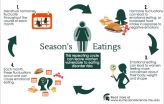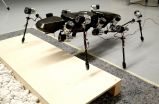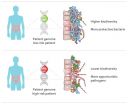Kent State Professor publishes exact solution to model Big Bang and quark gluon plasma
2014-12-16
(Press-News.org) Unlike in mathematics, it is rare to have exact solutions to physics problems.
"When they do present themselves, they are an opportunity to test the approximation schemes (algorithms) that are used to make progress in modern physics," said Michael Strickland, Ph.D., associate professor of physics at Kent State University.
Strickland and four of his collaborators recently published an exact solution in the journal Physical Review Letters that applies to a wide array of physics contexts and will help researchers to better model galactic structure, supernova explosions and high-energy particle collisions, such as those studied at the Large Hadron Collider at CERN in Switzerland. In these collisions, experimentalists create a short-lived high-temperature plasma of quarks and gluons called quark gluon plasma (QGP), much like what is believed to be the state of the universe milliseconds after the Big Bang 13.8 billion years ago.
In their article, Strickland and co-authors Gabriel S. Denicol of McGill University, Ulrich Heinz and Mauricio Martinez of the Ohio State University, and Jorge Noronha of the University of São Paulo presented the first exact solution that describes a system that is expanding at relativistic velocities radially and longitudinally.
The equation that was solved was invented by Austrian physicist Ludwig Boltzmann in 1872 to model the dynamics of fluids and gases. This equation was ahead of its time since Boltzmann imagined that matter was atomic in nature and that the dynamics of the system could be understood solely by analyzing collisional processes between sets of particles.
"In the last decade, there has been a lot of work modeling the evolution of the quark gluon plasma using hydrodynamics in which the QGP is imagined to be fluidlike," Strickland said. "As it turns out, the equations of hydrodynamics can be obtained from the Boltzmann equation and, unlike the hydrodynamical equations, the Boltzmann equation is not limited to the case of a system that is in (or close to) thermal equilibrium.
"Both types of expansion occur in relativistic heavy ion collisions, and one must include both if one hopes to make a realistic description of the dynamics," Strickland continued. "The new exact solution has both types of expansion and can be used to tell us which hydrodynamical framework is the best."
INFORMATION:
The abstract for this article can be found at http://journals.aps.org/prl/abstract/10.1103/PhysRevLett.113.202301.
For more information about Kent State's Department of Physics in the College of Arts and Sciences, visit http://www.kent.edu/cas/physics.
Media Contacts
Michael Strickland
mstrick6@kent.edu
330-672-3771
Emily Vincent
evincen2@kent.edu
330-672-8595
ELSE PRESS RELEASES FROM THIS DATE:
2014-12-16
The genetic abnormality that drives the bone cancer Ewing sarcoma operates through two distinct processes - both activating genes that stimulate tumor growth and suppressing those that should keep cancer from developing. These findings by Massachusetts General Hospital (MGH) investigators, published in the November issue of Cancer Cell, may lead to new therapies targeting these aberrant mechanisms.
The second most common bone cancer in children and young adults, Ewing sarcoma is caused by a chromosomal translocation - switching of genetic segments between two different ...
2014-12-16
EAST LANSING, Mich. - 'Tis the season of plenty of food and drink. While celebrating should be joyful, for some women, it's not. All the holiday temptations can add another layer to an already complicated biological process.
It's well known that women undergo hormonal changes every month due to the menstrual cycle. These changes can cause women to eat more, which is a natural, biological occurrence.
However, Michigan State University Foundation Professor Kelly Klump has found that the increased food intake causes some women to become much more preoccupied with their ...
2014-12-16
ITHACA, N.Y. - In the fight against global warming, carbon capture - chemically trapping carbon dioxide before it releases into the atmosphere - is gaining momentum, but standard methods are plagued by toxicity, corrosiveness and inefficiency. Using a bag of chemistry tricks, Cornell materials scientists have invented low-toxicity, highly effective carbon-trapping "sponges" that could lead to increased use of the technology.
A research team led by Emmanuel Giannelis, the Walter R. Read Professor of Engineering in the Department of Materials Science and Engineering, has ...
2014-12-16
HOUSTON -- (Dec. 16, 2014) -- In one of the most comprehensive laboratory studies of its kind, Rice University scientists traced the uptake and accumulation of quantum dot nanoparticles from water to plant roots, plant leaves and leaf-eating caterpillars.
The study, one of the first to examine how nanoparticles move through human-relevant food chains, found that nanoparticle accumulation in both plants and animals varied significantly depending upon the type of surface coating applied to the particles. The research is available online in the American Chemical Society's ...
2014-12-16
This news release is available in German. A research team at Bielefeld University has succeeded in teaching the only robot of its kind in the world how to walk. Its first steps have been recorded in a video. You can watch them in Bielefeld University's latest posting on 'research_tv'. The robot is called Hector, and its construction is modelled on a stick insect. Inspired by the insect, Hector has passive elastic joints and an ultralight exoskeleton. What makes it unique is that it is also equipped with a great number of sensors and it functions according to a biologically ...
2014-12-16
DURHAM, N.C. - Duke University scientists have developed new forensic tracers to identify coal ash contamination in water and distinguish it from contamination coming from other sources.
"These new tools can be used by federal and state regulatory agencies to monitor the environmental effects of coal ash and determine whether it has or hasn't impacted the environment," said Avner Vengosh, professor of geochemistry and water quality at Duke's Nicholas School of the Environment. "They can be used to trace the coal ash effluents to their source, even in watersheds where ...
2014-12-16
Washington, D.C.--New work from Carnegie's Ivan Naumov and Russell Hemley delves into the chemistry underlying some surprising recent observations about hydrogen, and reveals remarkable parallels between hydrogen and graphene under extreme pressures. Their work is the cover story in the December issue of Accounts of Chemical Research.
Hydrogen is the most-abundant element in the cosmos. With only a single electron per atom, it is deceptively simple. As a result, hydrogen has been a testing ground for theories of the chemical bond since the birth of quantum mechanics ...
2014-12-16
MINNEAPOLIS/ST. PAUL (12/16/2014)--A new study by an international team of researchers shows for the first time that people may inherit some of the intestinal bacteria that cause Crohn's disease and ulcerative colitis, collectively know as inflammatory bowel disease (IBD). The study, recently published in Genome Medicine, also confirmed that antibiotics could worsen the imbalance in the gut microbes.
About 1.6 million Americans suffer from Crohn's disease or ulcerative colitis, according to the Crohn's and Colitis Foundation of America. Understanding the causes of these ...
2014-12-16
AMHERST, Mass. - In a follow-up to her earlier studies of learning in infancy, developmental psychologist Lisa Scott and colleagues at the University of Massachusetts Amherst are reporting that talking to babies in their first year, in particular naming things in their world, can help them make connections between what they see and hear, and these learning benefits can be seen as much as five years later.
"Learning in infancy between the ages of six to nine months lays a foundation for learning later in childhood," Scott says. "Infants learn labels for people and things ...
2014-12-16
WASHINGTON, DC--December 16, 2014--Using mathematical modeling, researchers at New York and Vanderbilt universities have shown that commensal bacteria that cause problems later in life most likely played a key role in stabilizing early human populations. The finding, published in mBio®, the online open-access journal of the American Society for Microbiology, offers an explanation as to why humans co-evolved with microbes that can cause or contribute to cancer, inflammation, and degenerative diseases of aging.
The work sprung from a fundamental question in biology ...
LAST 30 PRESS RELEASES:
[Press-News.org] Kent State Professor publishes exact solution to model Big Bang and quark gluon plasma





